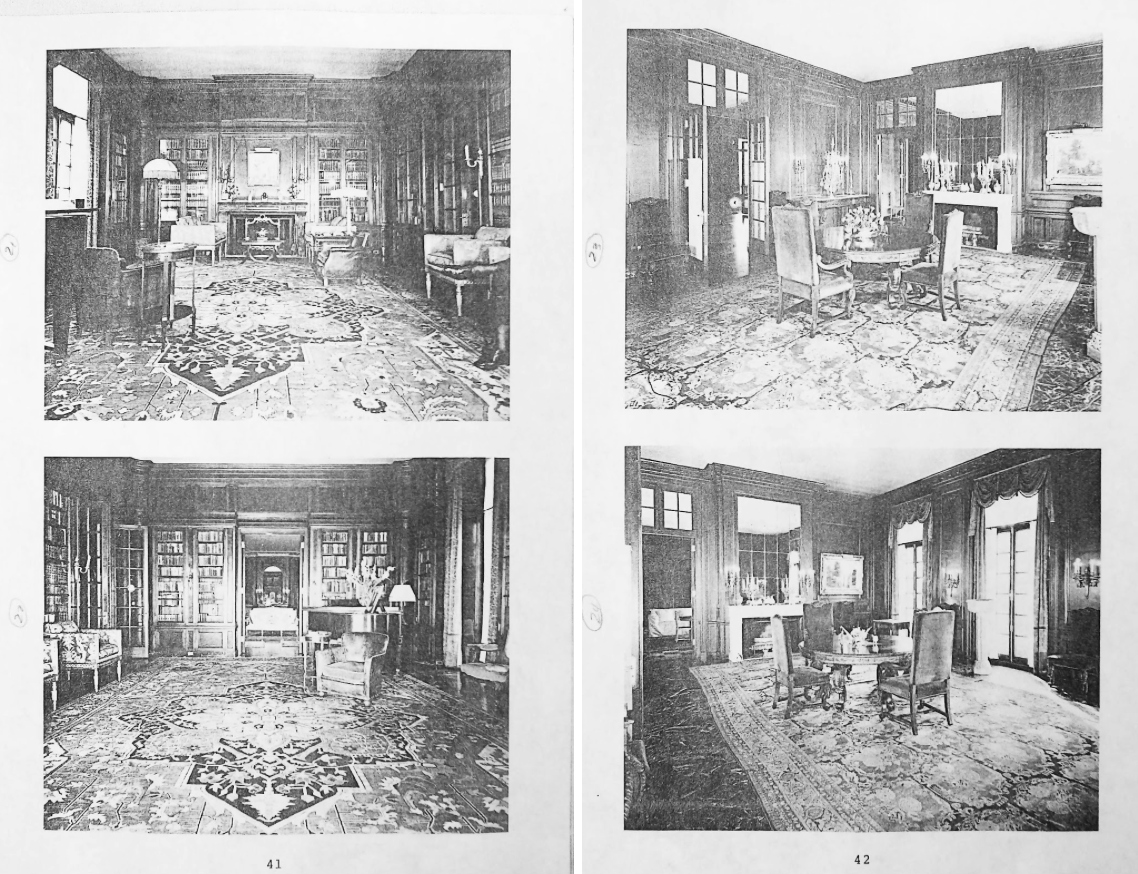Published by Tannaz Motevalli.
As one of the International Museum of Surgical Science’s Collection Interns, I have been working specifically in archiving documents pertaining to the house history and early College history. I’ve been able to get fascinating glimpses of what this historic mansion once held, from the time it was the home of the Countiss family to the first formative years of the Museum’s establishment. Two of the most intriguing accounts I’ve come across were written by Henrietta Countiss Vietta and Frank Isherwood. Henrietta Countiss Vietta was the eldest daughter of Fred and Eleanor Robinson Countiss. Frank and Eleanor were the first owners and occupants of the mansion that is now home to the Museum. In 1987, Henrietta wrote a short memoir entitled, “The House That Was A Home,” which details her family’s time growing up in the mansion. Frank Isherwood was one of the first employees at the International College of Surgeons (ICS) which is located next door in 1516 N. Lake Shore Drive. The College later bought the mansion (1524 N. Lake Shore) to turn it into what is now the International Museum of Surgical Science (IMSS). Between these two texts, two historic eras of the home are delicately illustrated. Something I love about these texts is that they are both written with evident affection for the place and the impact it left on their lives, despite being vastly different experiences. From Henrietta’s intimate perspective as a child in an affluent and active family in Chicago to Frank’s dedicated efforts to share his history as an employee and friend to Max Thorek, founder of ICS and IMSS; a complex and nuanced representation of this mansion and its many transformations is shared. But more importantly, I want to shed light on the impact of “the help” in these two documents.
Roughly one-third of Henrietta’s memoir is dedicated to providing a profile of the many employees that served her and her family. It is clear from both this dedication and the way her relationship with her mother is illustrated in the memoir, that, like many wealthy families, the Countiss children were raised by “the help” as much as, if not more than, their parents themselves. You see, Eleanor and her first husband Fred were extremely active socialites and philanthropists – they did not neglect their children, but as Henrietta writes, they were often too busy to have much one-on-one time with them. Henrietta states:
“One day a reporter asked her [Eleanor] if, busy as she was, she ever saw her children, suggesting that she might need an introduction to them after the war. Furious at the idea she neglected her responsibilities, she replied she lunched with them everyday which was true, except that during most noontime meals, she also held business conferences inviting people to share our luncheon…Where ‘we’ [Eleanor’s children] spent much of our relatively private time with Eleanor in those days was while she was getting dressed for the evenings activities, after our supper and before the grownups gathered… As she visited with us huddled together, many times with Rosemary in the now dry tub, out of her way but close by, we would learn the facts of life that seemed to be passing us by. We were free to ask questions, have our say and also be told things it was well for us to know. The state of the world became clear in this while we watched her dress up to the final adjusted outfit.”
And so, “the help” were as much family to Henrietta and the other children as their actual family; many of the employees providing much affection and life lessons to the children. The first member of the staff to be written about in Henrietta’s memoir was Ella Walsh, commonly known as Minie. Minie was first introduced to the Countiss family through Henrietta’s grandmother whom she served first. Minie was the housekeeper but her tasks were quite varied. She would sew clothes for the grandmother and the children, looked after the children, and traveled with the family from their various residences. She left service only to come back when Eleanor gave birth to Henrietta and stayed to remain as their housekeeper and “guardian angel” for Henrietta. Minie also would travel to the family’s farm in Lake Geneva, Wisconsin where she used to make jellies and jams, mince meat, make soaps and candles, sew slips, panties, blouses, dresses, jumpers, and nightgowns. Her half-brother, Charlie Morgan, raised chickens and grew his own produce on that farm, which the family ended up calling “Minie Acres.”

Photos taken by Frederick D. Countiss Jr. of the mansion in 1941
Then there was Rose Johns, who was sent by Dr. Holt, the head of the Children’s Hospital in New York, to care for the ailing baby son of Eleanor and Fred, born two years after Henrietta, who was quite asthmatic as a child and had terrible eczema. During World War I, Rose was classified as an “alien” and became one of eight foreign “detainees” given into the custody of Major General Eleanor Countiss. With Eleanor and Fred’s help, Rose was able to become a U.S. citizen and later they too helped get Rose’s brother to the U.S. Henriette writes, “we had a party with flags, a cake, horns and snappers, etc. on the day Rosie became a citizen.”
The Countiss family also had a beloved chauffeur named Jansen Christian Jensen. Henrietta writes, “Fred Jr. and Henrietta were his ‘children’ and he was a good and caring custodian, always alert to our needs and wishes.” Every year Jansen would decorate the Christmas tree and the Countiss children would go to his home to visit his wife and their black cat, Kitty, the day after Christmas. Jansen was quite the builder, too. One Christmas, Jansen built Henrietta a doll house which had been enjoyed by three generations of girls in the Countiss family. He also made a skating rink in the back yard, a slide which fit over the marble stairs of the mansion, and a “trapeze ring and swing set with ladders and braces customized for oversized kids to exercise on.” Days before he died in a Chicago hospital, a telegram was sent to notify Fred Jr. and Henrietta where he referred to them as “his family.”
There was also Taggert, the butler, “the perfect gentleman… a real character.” Taggert came to the mansion for all the important parties to announce the arriving guests, help clean the silver, supervise the table settings, answer the door and take coats and hats, serve cocktails and hors d’oeuvres, etc. all done in the exact manner as Eleanor wanted. Henrietta writes, “he watched Eleanor for direction, but usually could do her bidding without instruction.” On the day of Eleanor’s funeral, Henrietta spoke to Taggert for the last time and recounts the interaction quite vividly. Henrietta went to Taggert to ask if he had a place with the family at the front to watch the service. He replies, “Thank you, but no thanks.” When Henrietta asks why, Taggert said he did not want to enter the room, that he did not want to see, did not want to know, or have any memory of what was in that room. He later, with hesitation and grief, tells Henrietta he will be next. Taggert died the next week.
Henrietta wrote more small profiles on the many other employees who served her family, some with a similar amount of love and affection while some with a little bit of contempt and resentment. She does not attempt to paint a pretty picture, like all families and all workplaces, you cannot get along with everyone. But, I chose to share these four because their impact on Henrietta and their love for the Countiss family seemed so profound.
Frank Isherwood’s love for his work and his employer too was quite profound. In his draft entitled “The International College of Surgeons: Through the Eyes of a Most Loyal Employee,” Frank states that it was in 1947 when Max Thorek employed Frank and his wife to work at the then modestly staffed International College of Surgeons (ICS). That fall, the ICS held its first meeting in its newly purchased headquarters. Frank recounts buying folding chairs and tables and picking up the chicken lunches, coffee, and cake prepared by his wife for the meeting. Slowly over the first two years the College was renovated, plaques were bought, Mrs. Thorek was in charge of decorating, and “pride in the College began to show.” From the beginning of their employee-employer relationship, Frank’s job description remained muddy as Dr. Thorek relied on Frank to complete quite a wide variety of tasks from welcoming guests at the beginning of College meetings to picking the lock on the College safe when Dr. Thorek came one night and realized he forgot the key. But, as the College became more established and Council meetings and luncheons were hosted more regularly, Helen, Frank’s wife, became the official cook for the college, solidifying Frank and Helen’s commitment to their employer.
Though Frank and Helen were involved in the logistical labor required to keep the College up and running, Frank was like Dr. Thorek’s third and fourth hand and had begun to care just as deeply for the College and its growth as Thorek himself. In fact, it was Frank who notified Dr. Thorek when the mansion next door was on the market in 1951. Three years later the College obtained the mansion and began the renovation. Walls had to be torn down and new rooms made, and the place thoroughly cleaned. Once the rooms were ready to fill, Dr. Frederick Stenn and Frank assisted Dr. Thorek with the project of creating exhibits. Frank drew up the floor plans for all the rooms and Dr. Thorek had photostatic copies made which were then sent out to various international sections of the College to ask for their help in donating object to furnish the new exhibit rooms. The first room filled was the Argentina room, then Mexico, Italy, Spain, and the United States. Slowly new rooms were added: Peru, Brazil, France, Colombia, Canada, Israel, the Netherlands, and an X-ray room. The lecture hall was then filled with 12 large statues of great men and women in medicine and surgery – this room is now known as The Hall of Immortals.
For many years Frank oversaw the Museum and College, as the institutions grew in size, as the Museum exhibit rooms became completely filled and the collection continued to grow, when in 1956 Dr. Thorek began a lecture series open to the public – which has continued to be a major part of the Museum’s programming to this day, and when a Board of Directors for the Museum was formed. For 32 years, Frank and Helen remained dedicated and grateful employees. Frank writes:
“Dr. and Mrs. Max Thorek and Dr. Phil Thorek were very good to my wife and me. Dr. Max Thorek had removed our daughter’s appendix. Dr. Phil Thorek had removed an ovarian cyst from her and had taken care of me on numerous occasions, such as when I had pleurisy and pneumonia…I would like to say how much my wife and I have enjoyed working for the College and with the Thorek’s and Moses’ all these 32 years. It has been a wonderful experience, along with the friendships made that we shall always cherish.”
Sources:
- Countiss Vietta, Henrietta. “The House That Was Home.” May 7, 1987
- Isherwood, Frank. “The International College of Surgeons: Through the Eyes of a Most Loyal Employee.” August 24, 1983
Tannaz Motevalli is a Chicago-based artist, writer, and researcher. She is the current Collections Intern (Institutional Archives) at the International Museum of Surgical Science. Her interests include performative writing, the intersections of personal and institutional/systemic histories, and archives as a form of storytelling.

